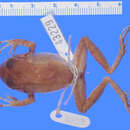Description
(
Inglês
)
fornecido por AmphibiaWeb articles
Pristimantis euphronides is a moderate-sized frog for its genus. Males have been known to have a maximum snout to vent length (SVL) of 27mm while females at 39.4mm. Labial areas are typically mottled, while a brown dorsum and cream venter are also exhibited. There exists a supratympanic stripe of dark shade that runs from the corner of the eye to the armpit. The thighs of the species are characterized by an orange-brown to red color, while the upper iris is bronze.The 2n = 32 chromosome complement is of a ZW/ZZ sex determination and displays an unusually large heterochromatic W chromosome. The findings of Schmid et al. (2002) classified the species as possessing one of the smallest genomes coupled with one of the largest W chromosomes among all amphibians.
- Germano, J. M., Sander, J. M., Henderson, R. W., and Powell, R. Powell. (2003). ''Herpetofaunal communites in Grenada: A comparison of variously altered sites and an annotated checklist of Grenadian amphibians and reptiles.'' Caribbean Journal of Science, 39(1), 68-76.
- Hedges, S.B. (1999). ''Distribution patterns of amphibians in the West Indies.'' Regional Patterns of Amphibian Distribution: A Global Perspective. W. E., Duellman, eds., Johns Hopkins University Press, Baltimore, 211-254.
- Kaiser, H. and Henderson, R.W. (1994). ''The conservation status of lesser Antillean frogs.'' Herpetological Natural History, 2(2), 41-56.
- Schmid, M., Feichtinger, W., Steinlein, C., Rupprecht, A., Haff, T., and Kaiser, H. (2002). ''Chromosomal banding in Amphibia. XXIII. Giant W sex chromosomes and extremely small genomes in Eleutherodactylus euphronides and Eleutherodactylus shrevei.'' Cytogenetic and Genome Research, 97(1-2), 81-94.
- Schwartz, A. (1967). Frogs of the genus Eleutherodactylus in the Lesser Antilles. Natuurwetenschappelijke studiekring voor Suriname en de Nederlandse Antillen, Amsterdam.
Distribution and Habitat
(
Inglês
)
fornecido por AmphibiaWeb articles
This species is most commonly found in mesic forests at elevations of over 300 meters on Granada (Kaiser and Henderson 1994) . More generally, the species may be located within altitudes of 300-840m, which has been listed as its elevational range (Hedges 1999) . An account has also been described near sea level at St. George’s (Schwartz 1967) .
Life History, Abundance, Activity, and Special Behaviors
(
Inglês
)
fornecido por AmphibiaWeb articles
Males of species Pristimantis euphronides and Eleutherodactylus johnstonei have been documented as calling side by side in the Grand Etang forest interior by (Germano et al. 2003) . The grayish eggs of P. euphronoides may be distinguished by their large diameter, relative to those of E. johnstonei.
Life History, Abundance, Activity, and Special Behaviors
(
Inglês
)
fornecido por AmphibiaWeb articles
While Kaiser et al. (1994b) reported a drop of this species population coupled with the encroachment of Eleutherodactylus johnstonei, Germano et al. (2003) documented the lack of a significant decline upon P. euphronides by the presence of E. johnstonei in the Grand Etang Forest Reserve.

